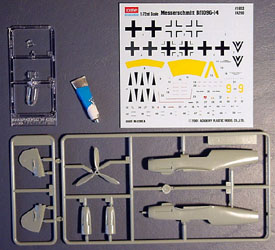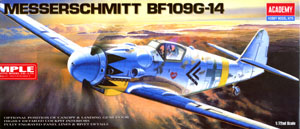Academy's 1/72 Messerschmitt Bf 109G-14 | | History Messerschmitt Bf 109 history? C'mon, everyone knows what a Bf 109 is! But what is a Bf 109G-14? The short answer is 'a mess'. Basically the Bf 109G-14 series came about as an attempt to standardize the many different changes made to the Bf 109G-6 production line. A noble attempt, but since the G-14 series was incorporated into the regular G-6 production lines, the end result was a type that was difficult to tell from a G-6 and with just as many differences. Most flew with the DB 605A engine with MW-50 injection, and the Erla-Haube canopy was standard. Like the late Bf 109G-6s, there was no standard antenna arrangement, with short, tall and none all present in G-14s. The tail was another area of change. G-14s could be found with either the short tail or with the tall tail. The tall tail came in two flavors, those with just a Flettner tab and those with the Flettner tab and two fixed trim tabs. Then there's the landing gear. The adoption of the larger 660x190 mainwheels led a small number of G-14s to have the large overwing bulges more commonly seen on the Bf 109G-10. The tailwheel unit also differed in the G-14 production run, with some having the original short tailwheel and others with the long type. Finally, the G-14/AS replaced the G-6/AS, but the only real difference was in the oil cooler, which was deeper on some of the G-14/AS airframes. Many, however, retained the oil cooler from the G-6/AS series, and thus were indistinguishable from that series. In short, the G-14 'standardization' went nowhere and the only real method of determining a G-14 from a G-6 is by looking at the Werk Nummer. A rough estimate of total production is around 5,500, and it is doubtful that this number will ever be known for sure due to the nature of overlapping WNr blocks and simultaneous production of G-6s & G-14s.  The Kit The Kit
So which version of G-14 is the Academy kit? This particular boxing is the tall tail, no antenna mast & short tailwheel version. There is a radio mast included, but it's marked as 'do not use'. It does give you the option should you decide on some other markings other than those in the kit. The basic breakdown of the kit parts clearly show that Academy is getting as far as they can with one basic set of molds, with the tail being separate from the fuselage and the upper cowling providing two different styles of gun troughs. While all the necessary parts aren't included, it appears that you could do anything from a G-5 through to a G-14, minus the AS-engined birds and the G-10. A new tail & canopy are all that's really needed to stretch this kit to all those other variants, and it's a pity that Academy doesn't include those in the kit to maximize your choices. In taking a closer look at the kit, the overall impression is a good one, with some basic cockpit detailing (including separately-molded trim wheels), which for an out-of-the-box build would result in a decent-looking cockpit. There's plenty of aftermarket sets for 1/72 Bf 109s, though, so those who want to really go to town can detail to their heart's content. With the interior finished the next step will probably be the most problematic, even with the nice molding of this kit. Since the tail is a separate piece it might be best to fit each tail half to the fuselage half before joining them. This way any step between the parts can be left on the seam side where it is easier to fix than on the outside. The forward cowling piece might also have some fit problems, although initial dry fitting shows that with some care this shouldn't be too much of a hassle.  The rest of the assembly is pretty straightforward. The kit provides a two-piece supercharger intake as well as the tropical filter to fit on front of it (although the G-14 didn't carry the trop filter - spares box fodder). The wings are built up out of three pieces, with the one-piece lower wing incorporating the radiator scoops. Also for under the wing are the cannon gondolas, and although those parts are marked 'do not use' some G-14s possibly carried them (or perhaps they were G-6s that were just misidentified as G-14s). Other bits to go under the wing include separate aileron mass balances and a separate drop tank rack, on which you have the option of two different styles of tanks to choose from. The rest of the assembly is pretty straightforward. The kit provides a two-piece supercharger intake as well as the tropical filter to fit on front of it (although the G-14 didn't carry the trop filter - spares box fodder). The wings are built up out of three pieces, with the one-piece lower wing incorporating the radiator scoops. Also for under the wing are the cannon gondolas, and although those parts are marked 'do not use' some G-14s possibly carried them (or perhaps they were G-6s that were just misidentified as G-14s). Other bits to go under the wing include separate aileron mass balances and a separate drop tank rack, on which you have the option of two different styles of tanks to choose from.
The decals offer up two choices, both interesting examples. The first one is the boxtop scheme, the white Erich Hartmann plane with the black tulip petals on the nose. While the plane is white over RLM 76, there are plenty of other interesting bits to make this scheme interesting. The decals provide the tulip petals as separate pieces (a total of 10), and the rest of the fuselage markings consist of the crosses, the double chevrons, and the yellow fuselage band. Unfortunately, the kit has no swastikas, not even halved examples to put together, so you'll have to scrounge through your spares for them (after digging through your references to figure out which style was applied to this plane, of course). Since this plane flew on the Eastern Front, the lower right wing has a yellow 'V' on it (provided as a decal). The only thing you have to paint on is the yellow underside of the cowling. The second example is a plane from JG 11 from 1945, complete with the Defense of the Reich bands around the rear fuselage & nose. This plane is camouflaged in RLM 74/75/76, with the cowling solid RLM 74. The rest of the fuselage is mottled and there's a yellow 9 ahead of the fuselage cross. The yellow Defense of the Reich band is provided as a decal, but the small band around the nose will need to be painted. Between the two schemes there's a total of six different cross styles, so you'll have plenty left over for your spares box. A complete set of stencilling is also included, which won't be of much use on Hartmann's (it was all painted over with the white temporary camouflage), but for the JG 11 bird you can decal to your heart's content. Conclusion There is no shortage of Bf 109 kits out there in 1/72 and choosing one can be daunting. Rest assured, though, that if you want to build a late model Bf 109G with the cowling bulges, this kit will get you there without much fuss, and an out of the box build will leave you pleased. References There's probably more books on the Bf 109 than any other aircraft out there, but the best book that describes the differences between the different Bf 109Gs would have to be Prien and Rodeike's 'Bf 109F, G, & K Series', printed by Schiffer, 1995. This book does an excellent job of outlining the differences in drawings, photos and text. Our thanks to MRC for the review sample. |


 




|
